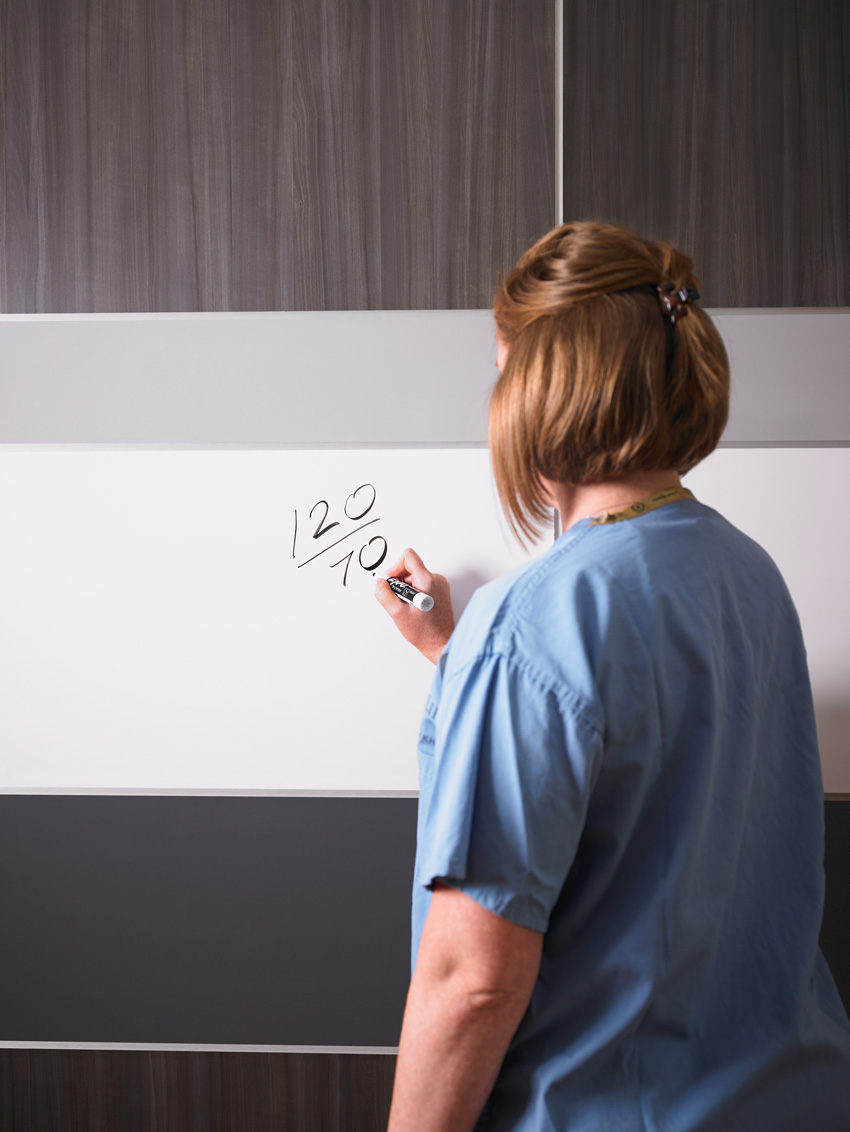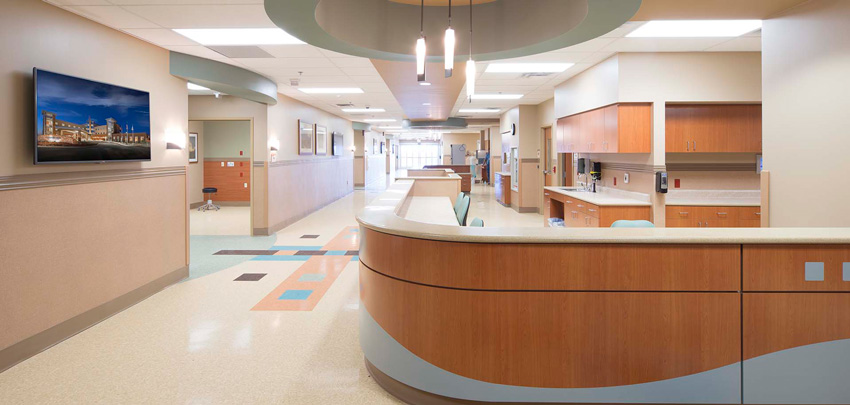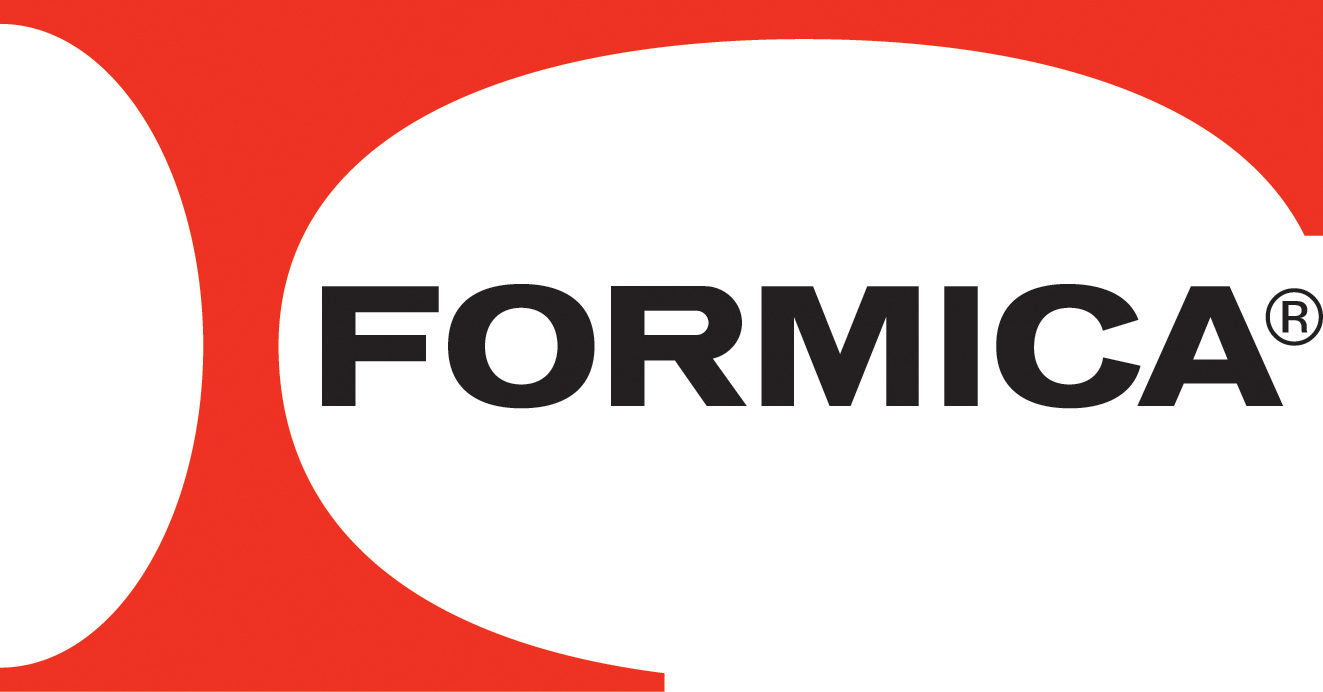Health-Care Surfaces: Marrying Function with Design
Patient Rooms and Nurses Stations
The challenge: Communication is key for a smoothly operating health-care facility. With nurses on different shifts moving in and out of patients’ rooms, and with doctors coming and going on their rounds, a highly visible method of communication can go a long way to cut down on mistakes and miscommunications.

Because miscommunication can lead to medical errors, added methods of communication are highly valued in a health-care setting. A magnetic whiteboard serves that function.
The specification: One way to facilitate communication and expression is specification of a magnetic laminate surface. This is an HPL with an iron foil incorporated under the surface décor and has a gloss finish. The iron foil gives the laminate its magnetic qualities. Magnetic laminates in gloss finish are especially suitable for use as marker boards or writing surfaces not only for nurses’ stations and patient rooms but also in education, office, and commercial environments. Text and images can be drawn onto the surface using a good-quality dry-erase marker and can be removed using a felt-based eraser. Depending on the quality of the markers, no ghosting should occur; however, if ghosting does occur, it can be removed by using whiteboard cleaning foam. Some laminate marker board products have grid points to provide a precision guide for writing or drawing. A product specified with a matte finish can be used as projection screen.
Pediatrician Offices and Children’s Hospitals
The challenge: Visiting a health-care facility is disconcerting enough for adults to handle and even more frightening for children. All attempts are made to create not only a safe and durable environment but also a happy and high-spirited space. The designer may have a color combination in mind to match a branding goal or wish to design something completely different and distinctive.
The specification: For a pediatrician’s office or children’s hospital where a cheerful and colorful aesthetic is absolutely necessary, a custom laminate product might be the best specification. For a designer, the possibility of creating a surface that is a unique piece of art on high-performance laminate is an appealing idea. This can be achieved using a design, photography, logo, illustration, or painting. The process involves melamine-impregnated decorative surface papers combined with phenolic-treated kraft paper and consolidated in a press at high pressures. The sheet back is sanded to maintain a uniform thickness and facilitate bonding.
Design Ideas for Health-Care Facilities
The need for clean, long-lasting surfaces in health care dictates several important design requirements as designers select and install surfaces.
Color: Neutral palettes that incorporate a calming blend of warm and cool colors are pleasing to the eye. Adding an occasional pop of color brings interest to cafeterias, gift shops, waiting areas, and pediatrics floors where subtle brights help establish a creative, welcoming environment.
Texture: Patterns that mimic natural elements like linen, stone, wood, plants, and even leather bring thoughts of home or hospitality settings. Textures reminiscent of the area, including mountains, deserts, water, and grasses, can be subtly mimicked in furniture and accent surfaces.
Visual diversity: Distraction from the events of the day is important in health care. Color and texture both play a role in this when it comes to visual diversity. This concept uses points of intrigue to give waiting family members or patients receiving treatments such as chemotherapy something interesting to observe. This can be achieved by blending woods, incorporating textured vertical surfaces for walls and doors, bringing in interesting colors, and highlighting local artwork.
Testing Standards and Certifications
For such high-functioning surfaces, which are required in a health-care setting, products must undergo rigorous testing, and achieve standards and certifications to ensure hard-surfacing products are safe and appropriate. Here is a sampling of some tests.
ASTM
Testing goal: Fungal resistance
Test: ASTM G21: Standard Practice for Determining Resistance of Synthetic Polymeric Materials to Fungi
According to ASTM: “The synthetic polymer portion of these materials is usually fungus resistant in that it does not serve as a carbon source for the growth of fungi. It is generally the other components, such as plasticizers, cellulosics, lubricants, stabilizers, and colorants, that are responsible for fungus attack on plastic materials.”8 For best results when fungal resistance is desired, consider a product that has passed this test.
Testing goal: Antibacterial
Test: JIS Z 2801/ISO 22196: Measurement of Antibacterial Activity on Plastics Surfaces and Other Nonporous Surfaces
This test method is designed to quantitatively test the ability of hard surfaces to inhibit the growth of microorganisms or kill them over a 24-hour period of contact. In this test method, according to one lab, “A bacterial suspension is applied to the test specimen and control pieces, in triplicate. Microorganism inoculated test pieces are then covered with a sterile thin membrane to spread the inoculum, avoid dehydration, and promote good contact between antimicrobial surface and the test organism. Samples are then incubated for 24 hours. Microbial counts are determined before and after incubation. Reduction of microorganisms is then calculated by using initial count and surviving microorganisms.”9
Scientific Equipment and Furniture Association (SEFA)
A product that is SEFA approved resists harsh chemicals. SEFA’s mission is to promote the use of laboratory-grade furniture, equipment, and fixtures. Manufacturers who want to have their products tested and proven compliant with SEFA’s Recommended Practices do so through one of 18 nationwide SEFA-approved independent third-party labs. For best results when resistance to harsh chemicals is desired, choose a product that is SEFA approved.
National Sanitation Foundation (NSF)
A product that meets the NSF Standard 35 is approved for food-contact surfaces. This standard establishes minimum sanitation requirements for the materials and fabrication of HPLs. For best results when the product will be used in food areas, choose a product that meets this standard.
Greenguard
Greenguard Gold Certified products meet strict chemical emissions limits, which contributes to the creation of healthier interiors. According to the organization, “Greenguard Gold Certification (formerly known as Greenguard Children & Schools Certification) offers stricter certification criteria, considers safety factors to account for sensitive individuals (such as children and the elderly), and ensures that a product is acceptable for use in environments such as schools and health-care facilities. It is referenced by both The Collaborative for High-Performance Schools (CHPS) and the Leadership in Energy and Environmental Design (LEED) Building Rating System.”10
Conclusion
Because of the numerous incidents of HAIs, cleanliness is arguably the most critical feature in a health-care setting. Surfaces and features must be cleanable and, if possible, resistant to bacteria, fungi, and other contaminants. Surfaces must additionally be durable in a very demanding environment. However, the surfaces specified for a health-care setting should also be soothing and calming for patients, their families, and the staff. A pleasant environment is also a critical factor in the overall goal of health care: to return the patient to wellness. Toward that end, architects and designers who specify products for a health-care facility will want to choose products that are not only tested and proven for the needs of each area in a setting but also aesthetically pleasing and harmonious. Rather than specifying products from a variety of disparate sources, the designer should choose high-performing surfaces within one manufacturer’s catalog to ensure the harmony between products that support the program: an environment that is clean, safe, durable, and beautiful.
End Notes
1“Guidelines for Environmental Infection Control in Health-Care Facilities: Recommendations of CDC and the Healthcare Infection Control Practices Advisory Committee (HICPAC).” U.S. Department of Health and Human Services. Centers for Disease Control and Prevention. 2003. Web. 4 January 2019.
2“National Action Plan to Prevent Health-Care-Associated Infections: Road Map to Elimination.” Office of Disease Prevention and Health Promotion. U.S. Department of Health and Human Services. Web. 4 January 2019.
3Part 1: Executive Summary, Metrics, and Goals. “National Action Plan to Prevent Health-care-Associated Infections: Road Map to Elimination.” Office of Disease Prevention and Health Promotion. U.S. Department of Health and Human Services. April 2003. Web. 4 January 2019.
4 “Guidelines for Environmental Infection Control in Health-Care Facilities: Recommendations of CDC and the Healthcare Infection Control Practices Advisory Committee (HICPAC).” U.S. Department of Health and Human Services. Centers for Disease Control and Prevention. 2003. Web. 4 January 2019.
5Han, Jennifer et al. “Cleaning Hospital Room Surfaces to Prevent Health-Care-Associated Infections: A Technical Brief.” Annals of Internal Medicine. American College of Physicians. Web. 4 January 2019.
6Stamp, Elizabeth and Alleyene, Allyssia. “Hospital designs that are changing the way you’re cared for.” CNN Style. 20 June 2017. Web. 4 January 2019.
7“Street artist Okuda San Miguel leaves his Younique mark on San Carlos Hospital.” Formica. Web. 4 January 2019.
8“ASTM G21 – 15: Standard Practice for Determining Resistance of Synthetic Polymeric Materials to Fungus.” ASTM International. Web. 4 January 2019.
9“Summary of ISO 22196 Test Method.” Accugen Labs. Web. 4 January 2019.
10“Greengold Gold Certification.” UL Environment. Web. 4 January 2019.
11“Canyon Vista Medical Center.” Gould Turner Group. Web. 4 January 2019. Kathy Price-Robinson is an award-winning housing and construction writer. Her series on home remodeling ran 12 years in the Los Angeles Times. She has profiled more than 500 projects and developed more than 100 continuing education courses. www.linkedin.com/in/kathypricerobinson












